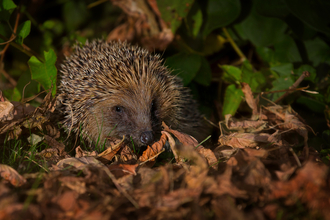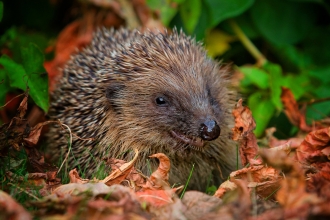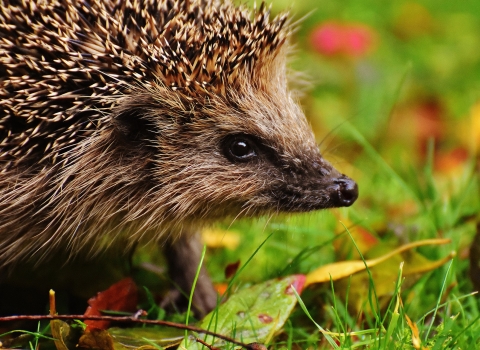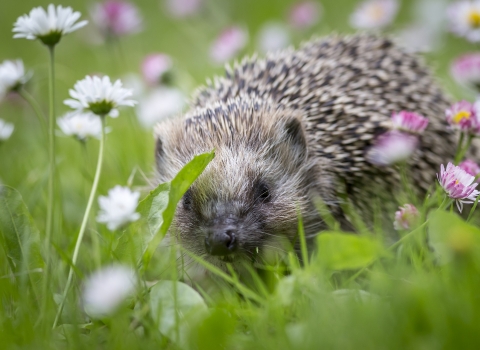Thank you for taking part in our fun Hedgehog quiz. We hope you enjoyed it. Please find the answers below.
1. Which of these are genuine Hedgehog names (tick all that apply):
The correct answers were:
- Urchin
- Draenog
- Hedgepig
The European Hedgehog goes by many names; the majority in Europe appear to derive from the Greek word for snake – presumably referring to the hedgehog’s high tolerance to some snake venom and its propensity for eating them on occasion! Then follows a web of uses relating to the words for prickle or spike. Many of the dialect names in English appear to be derived from the word urchin, as in the sea urchin which shares a prickly nature with our garden friends. To see more hedgehog names, have a go at our hedgehog wordsearch below.
2. Are these Hedgehog footprints?
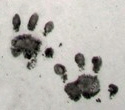
Yes, these are Hedgehog fooprints; don't they look like little hands?! Both the front and back feet have five toes, though often only four toes show up on the tracks. The front feet are wider than the back feet. Hedgehogs can be difficult to detect, but searching for their footprints is a good way of discovering if they are around. You can make a footprint trap to look for them in your own garden, download the plans below.
3. How many spines do adult Hedgehogs have?
Hedgehogs are known for their ability to roll themselves into a ball of spines when threatened; it is a very effective protection against most predators. These spines are actually modified hairs and the average adult hedgehog has between 5,000 and 7000 of them, which can be raised using powerful muscles along their back.
4. Which of these statements are correct?
Hedgehogs have been accused of all sorts of crimes, many of which are simply not true. They don't roll on fruit to carry it away, nor do they suck milk from cow's udders, although they may lap at some if they find it. Hedgehogs eat a wide range of foodstuffs. Whilst insects form the major part of their diet, they also eat slugs, snails, birds eggs, fruit and will even scavenge from dead animals.
5. How far can a foraging hedgehog travel in a single night?
This was a bit of a mean question, as the emphasis here is 'foraging'. Hedgehogs can travel 2km in a single night, when looking for food, so the right answer is 'About 2km'. Males, when searching for a mate, can travel as much as 3km. This is why it is very important to have a well-connected wildlife-rich landscape for hedgehogs.
Download our hedgehog maze below - can you help this little hedgehog do her nightly rounds, travelling to all the hedgehog-friendly places and avoiding the dead ends?
6. How can you help hedgehogs in your garden (tick all that apply)?
As you probably worked out, all the answers to this one were correct. There are many things we can all do in our gardens to help our spiny friends. For more information and ideas, click here.
7. What's going on here?
© Tamasine Stretton
How do hedgehogs mate? Carefully! This is not far from the truth. Hedgehog courtship can last for hours, with the male moving round and chasing the female. It is a noisy affair, which much snorting and grunting! The female will only lay her spines flat for mating if she likes the male enough!
8. Which is the best hedgehog home (tick all that apply)?
Natural features, like log piles, compost heaps or a messy corner, make the best hog homes, but artificially built ones are also used. If you have the space, aim to provide a good variety in your garden.
For more information on making a hedgehog home, click here.
9. Which of these hedgehogs need help (tick all that apply)?
All these answers are correct:
- Any time a hoglet is without an adult, it is likely to be in need to help;
- No healthy hedgehog will sunbathe, they are nocturnal, so usually if they are out in the day, they need help, but especially if they are lethargic or wobbly;
- Crows, or other corvids, as birds of the day, so if they are attacking a hedgehog, it is likely to be in need to assistance;
- If flies are covering any animal, they are attracted to something; it's not a good sign with hedgehogs.
For more information on how to help a hedgehog, click here.
10. What is this Hedgehog doing?
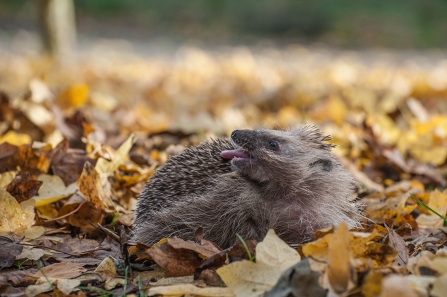
Self annointing hedgehog © Gillian Lloyd
Hedgehogs have a lot of odd behaviours; it is one of the things which we find attractive about them. Although it might look like it is just grooming, this hedgehog is doing one such strange behaviour - 'self-annointing'. A hedgehog will produce copious saliva, contort itself into all sorts of shapes and frantically & obsessively try to cover itself in froth. It usually starts suddenly and finishes just as suddenly. Not all individuals do it, but neither is it confined to our hedgehog (search for self-annointing on YouTube and you will see pet hedgehogs doing it).
Noone knows for sure why hedgehogs do this. Theories include predator or parasite repellent, but most likely it is something to do with scent. Maybe the hedgehog wishes to make itself more obvious to others of its kind, either to deter competors to attract a mate?

